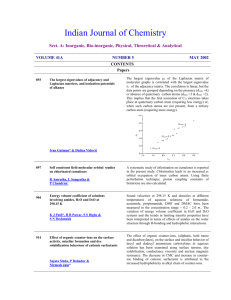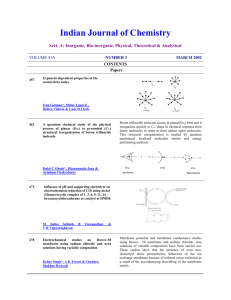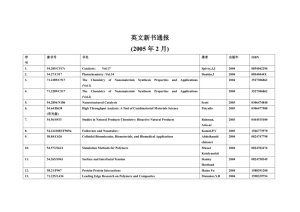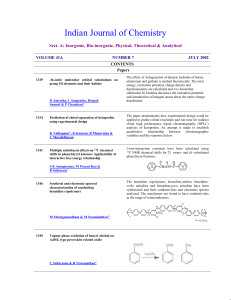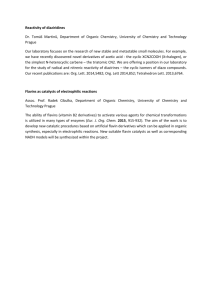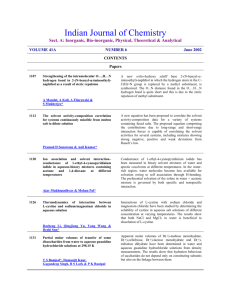Ijca-august2k2
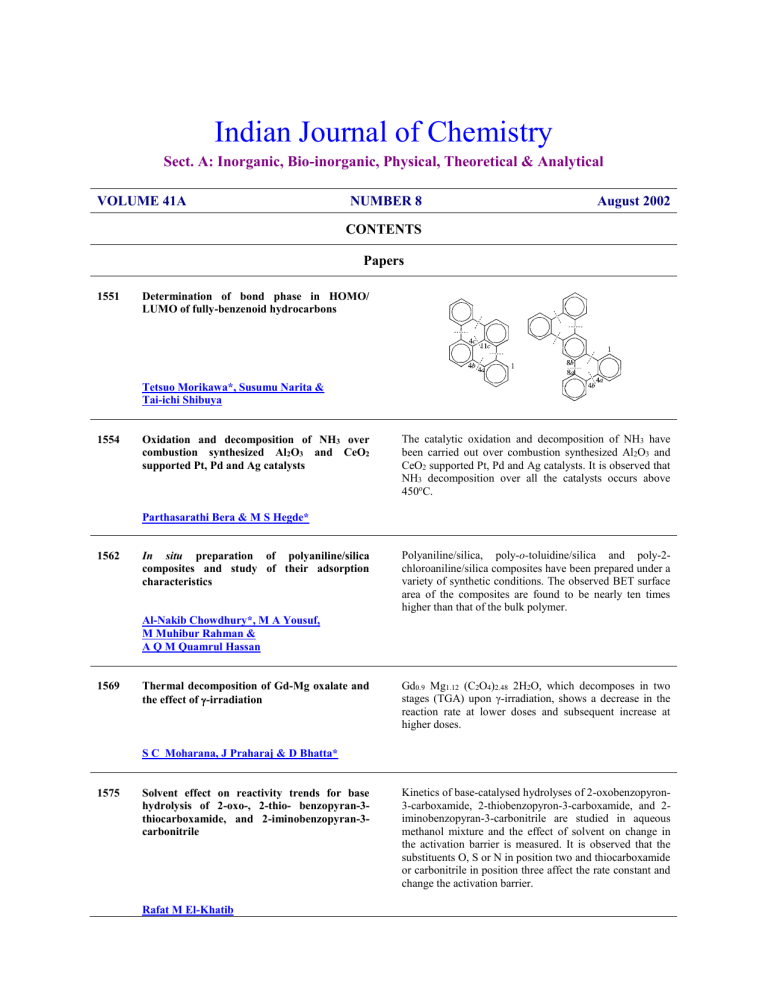
Indian Journal of Chemistry
Sect. A: Inorganic, Bio-inorganic, Physical, Theoretical & Analytical
VOLUME 41A NUMBER 8 August 2002
CONTENTS
1551
1554
1562
1569
1575
Papers
Determination of bond phase in HOMO/
LUMO of fully-benzenoid hydrocarbons
Tetsuo Morikawa*, Susumu Narita &
Oxidation and decomposition of NH
3
over combustion synthesized Al
2
O
3
and CeO
2 supported Pt, Pd and Ag catalysts
Parthasarathi Bera & M S Hegde*
The catalytic oxidation and decomposition of NH
3
have been carried out over combustion synthesized Al
2
O
3
and
CeO
2
supported Pt, Pd and Ag catalysts. It is observed that
NH
3
decomposition over all the catalysts occurs above
450 o C.
In situ preparation of polyaniline/silica composites and study of their adsorption characteristics
Al-Nakib Chowdhury*, M A Yousuf,
Thermal decomposition of Gd-Mg oxalate and the effect of
-irradiation
S C Moharana, J Praharaj & D Bhatta*
Solvent effect on reactivity trends for base hydrolysis of 2-oxo-, 2-thio- benzopyran-3thiocarboxamide, and 2-iminobenzopyran-3carbonitrile
Polyaniline/silica, polyotoluidine/silica and poly-2chloroaniline/silica composites have been prepared under a variety of synthetic conditions. The observed BET surface area of the composites are found to be nearly ten times higher than that of the bulk polymer.
Gd
0.9
Mg
1.12
(C
2
O
4
)
2.48
2H
2
O, which decomposes in two stages (TGA) upon γ-irradiation, shows a decrease in the reaction rate at lower doses and subsequent increase at higher doses.
Kinetics of base-catalysed hydrolyses of 2-oxobenzopyron-
3-carboxamide, 2-thiobenzopyron-3-carboxamide, and 2iminobenzopyran-3-carbonitrile are studied in aqueous methanol mixture and the effect of solvent on change in the activation barrier is measured. It is observed that the substituents O, S or N in position two and thiocarboxamide or carbonitrile in position three affect the rate constant and change the activation barrier.
1580
1588
1593
1600
1604
1607
Studies on solvation interaction: Solubility of a betaine dye and a ketocyanine dye in homogeneous and heterogeneous media
Ramkrishna Pramanik & Sanjib
Bagchi*
Viscometric studies of molecular interactions in ternary liquid mixtures of ethane-1,2-diol with some polar and non-polar solvents
Surabhi Singh & Mukhtar Singh*
Solubility of 2,6-diphenyl-4-(2,4,6-triphenylpyridinium-1yl) phenolate, and a ketocyanine dye has been determined in binary solvent mixtures and in cationic and anionic micellar media. The results have been explained in terms of solute-solvent and solvent-solvent interaction. Study in micellar media provides information regarding the location of the dye in the heterogeneous media.
Densities and viscosities of ternary liquid mixtures of ethane-1,2-diol with some polar and non-polar solvents have been measured as a function of the composition at a constant temperature. The results have been discussed in regard to the nature and strength of molecular interactions between the mixing components.
Excess volumes and viscosities of N–methyl–2– pyrrolidinone with branched alcohols at
298.15 K
Ternary complexes of iron(III) with 1,2-bis(2hydroxybenzamido)ethane, thiocyanate and sulphur(IV): A kinetic study.
Harapriya Rath & Anadi C. Dash*
Excess volumes ( V m
E ) and viscosities (
) of binary liquid mixtures of N–methyl-2–pyrrolidinone with branched alcohols have been measured as a function of composition.
The V m
E for each of the mixtures studied are negative over the entire composition range.
Fe(L)(OH
2
)
2
+
+HSO
3
K d
↓↑ k
1
Fe(L)(OH
2
)(SO
3
)
+ H
+
H +
Fe(L)(OH
2
)
2
+
+
+SO
3
2
Q
{Fe(L)(OH
2
)
2
+
,SO
3
2
} k
2
Fe(L)(OH
2
)(SO
3
)
Notes
Enumeration of non-equivalent carbon atoms in finitely large triangulenes, rhombulenes and related structures
Tapanendu Ghosh, Sujit Sankar Panja &
Hydrodechlorination of dichlorodifluoromethane over novel CrF
3 supported palladium catalysts
Novel CrF
3
supported palladium catalysts have been prepared through two different precursors These catalysts exhibit improved catalytic activities in hydrodechlorination of CFC-12 as compared with conventional Pd/
-Al
2
O
3
.
1612
1616
1619
1621
1625
1629
Kinetics and mechanism of oxidation of lower oxyacids of phosphorus by tetrabutylammonium tribromide
Synthesis, characterization and ion exchange properties of a new inorganic ion exchange material: Zirconium(IV) iodooxalate
J P Rawat*, Premvir Singh & Nafisur
Synthesis and characterization of complex
[Mn(
1 -pyS)(dien)(CO)
3
] by the reaction of
[Mn
2
(
-pyS)
2
(CO)
6
] (pySH=pyridine-2-thiol) and diethylenetriamine (dien)
Synthesis and characterisation of saccharide complexes of La(III) ion
Erkki Kolehmainen & Chebrolu Pulla Rao*
R PH (O) OH + Br
3
slow
R
P
(O)
OH + HBr
+ 2 Br
R
P
(O)
OH + H
2
O fast
RP(O)(OH)
2
+ H +
A new three component inorganic ion exchange material zirconium (IV) iodooxalate (ZIO) has been synthesized.
The ion exchange capacity varies and is found to be depend upon the crystal ionic radius of exchanging cations.
H
2
N
N
H
2
N
N
3
O
C
M n
S
CO
CO
Metal-pyridylcarboxypropanamide (PCPAH) and metal-pyridylcarboxy-benzamide
(PCBAH) interactions : Stability constant, chemical speciation and molecular modelling studies
B S Garg*, R K Sharma*, R Shrestha,
Synthesis and spectral studies on copper(II) and cobalt(II) complexes of macrocyclic ligand containing thiosemicarbazone moiety
New copper(II) and cobalt(II) complexes of macrocyclic
Schiff base ligand containing thiosemicarbazone moiety have been synthesized and characterized.
1634
1639
1643
1646
1652
Synthesis of N,N-dialkyl dithiocarbamate triphenyltin(IV) and crystal structures of
Ph
3
SnS
2
CN(C
2
H
5
)
2
and Ph
3
SnS
2
CN(C
5
H
10
)
Dezhong Zhu, Rufen Zhang, Chunlin Ma* &
Synthesis and characterisation of some phthalanilic and maleanilic acid derivatives of arsenic(III)
H P S Chauhan*, R K Singh, B Porwal &
Simultaneous second derivative spectrophotometric determination of nickel(II) and copper(II) using diacetylmonoxime isonicotinoyl hydrazone
K B Chandrasekhar & K Hussain Reddy*
Differential pulse polarographic determination of lead(II) in complex materials after adsorption of its trifluoroethylxanthate-cetyltrimethylammonium ion-associated complex on microcrystalline naphthalene or on trifluoroethylxanthatecetyltrimethylammonium-naphthalene adsorbent
B K Puri*, Atamjyot, Keemti Lal &
Lead(II) is adsorbed as lead trifluoroethylxanthate- cetyltrimethylammonium adsorption is only 80%. ion pair complex on microcrystalline naphthalene quantitatively. In the absence of cetyltrimethylammonium as the counter ion, the
Sodium anthraquinone-2-sulphonate sensitized photoreduction of methylene violet
Authors for correspondence are indicated by (*)
Vol. 41A, August 2002, pp. 1551-1553
Determination of bond phase in HOMO/LUMO of fully-benzenoid hydrocarbons
Tetsuo Morikawa*, Susumu Narita & Tai-ichi Shibuya
Classical valence theory suggests the existence of 'quasi-single' bonds in a class of benzenoid hydrocarbons, called fully-benzenoid hydrocarbons such a bond connects one aromatic sextet with another. The phase of a bond is defined as the sign either plus for bonding or minus for antibonding. We conclude by use of perturbation molecular orbital theory that the bond phase of quasi-single bonds has always the minus sign in HOMO of fully-benzenoid hydrocarbons; the bond phase alters in HOMO and LUMO.
Vol. 41A, August 2002, pp. 1554-1561
Oxidation and decomposition of NH
3
over combustion synthesized Al
2
O
3
and
CeO
2
supported Pt, Pd and Ag catalysts
Parthasarathi Bera & M. S. Hegde
The catalytic oxidation and decomposition of NH
3
have been carried out over combustion synthesized Al
2
O
3 and CeO
2
supported Pt, Pd and Ag catalysts using temperature programmed reaction (TPR) technique in a packed bed tubular reactor. Metals are ionically dispersed over CeO
2
and fine metal particles are found on Al
2
O
3
. NH
3 oxidation occurs over 1% Pt/Al
2
O
3
, 1% Pd/Al
2
O
3
and 1% Ag/Al
2
O
3
at 175, 270 and 350 o C respectively producing
N
2
, NO, N
2
O and H
2
O, whereas 1% Pt/CeO
2
, 1% Pd/CeO
2
and 1% Ag/CeO
2
give N
2
along with NO, N
2
O and H
2
O at 200, 225 and 250 o C respectively. N
2
predominates over other N-containing products during the reaction on all catalysts. At less O
2
concentration, N
2
and H
2
O are the only products obtained during NH
3
oxidation. NH
3 decomposition over all the catalysts occurs above 450 o C.
Vol. 41A, August 2002, pp. 1562-1568
In situ preparation of polyaniline/silica composites and study of their adsorption characteristics
Al-Nakib Chowdhury*, M. A. Yousuf , M Muhibur Rahman & A. Q. M. Quamrul Hassan
Polyaniline/silica, polyotoluidine/silica and poly-2-chloroaniline/silica composites have been prepared under a variety of synthetic conditions by polymerizing the respective monomers in the presence of silica prepared in situ from an aqueous sodium silicate solution. The composites, thus synthesized, have been characterized by a wide
range of experimental techniques including elemental analysis for silica content, density, infrared spectroscopy and sedimentometry for particle size determination. When used as column material in the IGC experiments, synthesized composites have been found to be capable of separating the alkanes (C
5
C
9
) from their mixture. The composites have been further examined for their surface free energy and specific surface area. The observed BET surface area of the composites were found to be nearly ten times higher than that of the bulk polymer.
Vol. 41A, August 2002, pp. 1569-1574
Thermal decomposition of Gd-Mg oxalate and the effect of
-irradiation
S.C. Moharana, J. Praharaj & D. Bhatta
Decomposition of Mg and Gd oxalates, mechanical mixture and co-precipitated (unirrad. and irrad.) Gd-Mg oxalate has been studied by adopting rising temperature technique. The kinetics of the decomposition are investigated using thermogravimetry. The TG-DTA data exhibit two different stages of weight loss and endotherms, corresponding to individual components in the co-precipitate. Kinetic parameters for different stages are obtained by applying best fit models of solid state reactions in the Coats-Redfern’s equation. Effects of irradiation and coprecipitation technique on the mechanism of decomposition of Gd-Mg ox have been studied.
Vol. 41A, August 2002, pp. 1575-1579
Solvent effect on reactivity trends for base hydrolysis of 2-oxo-,
2-thio- benzopyran-3-thiocarboxamide, and 2-iminobenzopyran-3carbonitrile
Rafat M. El-Khatib
Kinetics of base-catalysed hydrolyses of 2-oxobenzopyron-3-carboxamide, 2-thiobenzopyron-3-carboxamide, and 2-iminobenzopyran-3-carbonitrile are studied in aqueous methanol mixture and the effect of solvent on change in the activation barrier (δ m
Δ
G
≠
) is measured. Solvent effects on reactivity trends for base hydrolysis of these compounds have been analysed into initial state and transition state components which are determined from transfer chemical potentials and kinetic data. It is observed that the substituents O, S or N in position two and thiocarboxamide or carbonitrile in position three affect the rate constant and change the activation barrier
Vol. 41A, August 2002, pp. 1580-1587
Studies on solvation interaction. Solubility of a betaine dye and a ketocyanine dye in homogeneous and heterogeneous media.
Ramkrishna Pramanik & Sanjib Bagchi *
Solubility of 2,6-diphenyl-4-(2,4,6-triphenylpyridinium-1-yl) phenolate, commonly known as Reichardt’s betaine dye and a ketocyanine dye has been determined in binary solvent mixtures and in cationic and anionic micellar media. In all the binary mixtures the standard molar free energy of solution, as given by log s
12
where s
12 is the solubility in the binary mixture, cannot be represented by the average of log s values in pure solvents weighted with respect to mole fraction of the components. The deviation from the mole fraction average value, as given by
( log s )= log s
12
( x
1 log s
1
x
2 log s
2
), has been calculated and compared with the similar parameter as obtained from the electronic spectroscopic transition energy. The results have been explained in terms of solute-solvent and solvent-solvent interaction. Study in micellar media provides information regarding the location of the dye in the heterogeneous media.
Vol. 41A, August 2002, pp. 1588-1592
Viscometric studies of molecular interactions in ternary liquid mixtures of ethane-1,2-diol with some polar and non-polar solvents
(Ms.) Surabhi Singh & Mukhtar Singh*
Densities and viscosities of ternary liquid mixtures of ethane-1,2-diol with some polar (acetone and methyl ethyl ketone) and non-polar(benzene, toluene, carbon tetrachloride) solvents have been measured as a function of the composition at a constant temperature 298.15 K. From the density and viscosity data the excess thermodynamic properties, viz., the excess molar volume (V E ), the excess viscosity(
E ) and the excess
Gibbs free energy of activation of flow (
G #E ), have been calculated. On the basis of the values of excess thermodynamic properties and that of the parameter d (in Grunberg and Nissan equation) the results have been discussed in regard to the nature and strength of molecular interactions between the mixing components.
Vol. 41A, August 2002, pp. 1593-1599
Excess volumes and viscosities of N–methyl–2–pyrrolidinone with branched alcohols at 298.15 K
Amalendu Pal * , Anil Kumar, B R Arbad & A B Tekale
Excess volumes ( V m
E ) and viscosities (
) of binary liquid mixtures of N–methyl-2–pyrrolidinone with branched alcohols have been measured as a function of composition at 298.15 K. The branched alcohol includes 2– propanol, 2-methyl-1-propanol, 3-methyl-1-butanol, and 2-methyl-2-propanol. The V m
E for each of the mixtures studied are negative over the whole composition range. From the experimental data, the deviation in viscosities (
) and excess energies of activation (
G *E ) for viscous flow have been calculated. These values are negative over the entire range of composition. The results for V m
E ,
, and
G *E are discussed in terms of interaction between components. The viscosity data have been correlated with the equations of McAllister, Heric, and Auslaender.
Vol. 41A, August 2002, pp. 1600-1603
Ternary complexes of iron(III) with 1,2-bis(2-hydroxybenzamido)ethane, thiocyanate and sulphur(IV): A kinetic study.
Harapriya Rath & Anadi C. Dash *
The kinetics of anation of (diaqua)(1,2-bis(2-hydroxybenzamido)iron(III) by NCS - and S IV (HSO
3
and SO
3
2) are reported at 25 o C, I = 0.5 mol dm -3 in 20%(v/v) MeOH + H
2
O medium. The formation of the monothiocyanato complex, Fe(L)(OH
2
)(NCS), is reversible. The monosulphito complex, Fe(L)(OH
2
)(SO
3
) is formed via the reaction of the diaqua complex with HSO
3
and SO
3
2; dissociation of the sulphito complex to the reactants has not been observed. Ion-pairing of the diaqua complex with SO
3
2 (but not with HSO
3
) has been identified kinetically and resulted in the reduced reactivity of SO
3
2 in comparison to HSO
3
. The results are consistent with the dissociative mode of activation for the aqua ligand substitution of Fe(L)(OH
2
)
2
+ . It has been found that there is no significant labilising action of the coordinated phenoxide and amide functions of the primary ligand (L 2) on the aqua ligand replacement reaction at iron(III) center
.
Vol. 41A, August 2002, pp. 1604-1606
Enumeration of non-equivalent carbon atoms in finitely large triangulenes, rhombulenes and related structures
Tapanendu Ghosh , Sujit Sankar Panja & Asok K Mukherjee*
Simple analytic expressions for the number of non-equivalent carbon atoms (NEC) which is important in counting 13 C NMR signals in some classes of polynuclear aromatic hydrocarbons, viz., linear polyacenes, flanked pyrenes, triangulenes and rhombulenes have been deduced using Pólya’s enumeration theorem (PET) and Balasubramanian’s method of reduced cycle indices. Given only a very obvious structural feature of the molecular graph, these analytical expressions directly yield the NEC value and construction of the cycle index and reduced cycle index can be avoided. Moreover, in case of triangulenes NEC has been shown to be obtainable from a flow-chart which is easy to construct and for rhombulenes NEC has been shown to be obtainable from Pascal’s triangle.
Vol. 41A, August 2002, pp. 1607-1611
Hydrodechlorination of dichlorodifluoromethane over novel CrF
3
supported palladium catalysts
Yu Cai Cao & Xuan Zhen Jiang*
Novel CrF
3
supported palladium catalysts have been prepared through two different precursors i.e. dichlorobistriphenyl-phosphine palladium (DCTPPP) and PdCl
2
for the hydrodechlorination of CFC-12. These catalysts exhibited improved catalytic activities in hydrodechlorination of CFC-12 as compared with conventional
Pd/
-Al
2
O
3
. Particularly, high selectivities (~81%) of CH
2
F
2
formation have been achieved over DCTPPP/CrF
3
. The improved catalytic performance may be attributed to the nature of support CrF
3
and the formation of fine palladium particles in the catalysts.
Vol. 41A, August 2002, pp. 1612-1615
Kinetics and mechanism of oxidation of lower oxyacids of phosphorus by tetrabutylammonium tribromide
Pradeep K Sharma
Oxidation of lower oxyacids of phosphorus by tetrabutylammonium tribromide (TBATB) in aqueous acetic acid leads to the formation of corresponding oxyacids with phosphorus in a higher oxidation state. The reaction exhibits
1:1 stoichiometry. The reaction is first order each in [TBATB] and [oxyacids]. The reaction does not induce polymerization of acrylonitrile. There is no effect of tetrabutylammonium chloride on the reaction rate. The proposed reactive oxidizing species is tribromide ion. It has been shown that the pentacoordinated tautomer of the phosphorus oxyacid is the reactive reductant. The oxidation of deuteriated oxyacids exhibits a substantial primary kinetic isotope effect. The effect of solvent composition indicates that the rate increases with an increase in the polarity of the solvent. A mechanism involving transfer of a hydride ion in the rate-determining step has been proposed.
Vol. 41A, August 2002, pp. 1616-1618
Synthesis, characterization and ion exchange properties of a new inorganic ion exchange material: Zirconium(IV) iodooxalate
J P Rawat*, Premvir Singh & Nafisur Rahman
A new three component inorganic ion exchange material zirconium (IV) iodooxalate (ZIO) has been synthesized by adding a mixture of 0.1
M potassium iodate and 0.1
M oxalic acid to 0.1
M zirconium oxychloride in different volume ratios at p H 1. Among several samples synthesized, ZIO-6 is selected for detailed studies owing to its highest ion exchange capacity and chemical stability. The material has been characterized on the basis of chemical composition, p H-titration, FTIR and thermogravimetric studies. The ion exchange capacity of the material for Na + ion has been found to be 2.70 meq g
1 dry exchanger. The ion exchange capacity varies and is found to be depend upon the crystal ionic radius of exchanging cations. The chemical stability of the material has been tested in acidic, neutral and basic media. The sorption studies of some metal ions have been made in distilled water and nitric acid.
Vol. 41A, August 2002, pp. 1619-1620
Synthesis and characterization of complex [Mn(
1
-pyS)(dien)(CO)
3
] by the reaction of [Mn
2
(
-pyS)
2
(CO)
6
] (pySH=pyridine-2-thiol) and diethylenetriamine (dien)
Gulsan Ara, Shariff E Kabir & Kalipada Kundu*
The dimeric complex [Mn
2
(
-pyS)
2
(CO)
6
] ( 1 ) reacts with 2 molar equivalents of diethylenetriamine (dien) to give the monomeric complex [Mn(
1 -pyS)(dien)(CO)
3
] ( 2 ) in which the pyridine-2-thiolato group coordinates to manganese through the S-atom as a two-electron donor ligand. The complex has been characterized by elemental analysis and IR, PMR and mass spectroscopy.
Vol. 41A, August 2002, pp. 1621-1624
Synthesis and characterisation of saccharide complexes of La(III) ion
Anindita Mukhopadhyay, Erkki Kolehmainen a ,
Chebrolu Pulla Rao*
A series of ten La(III)-saccharide complexes have been synthesised with eight different monosaccharides ( D -
( glucose, D -fructose, D -galactose, D -mannose, L -sorbose, D -arabinose, D -ribose and D -xylose) and two disaccharides
D -maltose and D -lactose), and characterised by analytical, spectral and electrochemical techniques. 13 C NMR spectra reveal interesting binding modes of saccharide molecules towards La(III).
Vol. 41A, August 2002, pp. 1625-1628
Metal-pyridylcarboxypropanamide (PCPAH) and metal-pyridylcarboxybenzamide (PCBAH) interactions : Stability constant, chemical speciation and molecular modelling studies
B S Garg*, R K Sharma*, R Shrestha, Sachin Mittal & M Sarbhai
Chemical speciation and molecular modeling studies have been carried out for accessing the interactions of metal ion with some amide containing ligands. Chemical speciation has been carried out using the program BEST and SPE and method of Bjerrum and Calvin, as modified by Irving and Rassotti has been used to find out the values of stabilityconstants. The order of stability constants is found to be fairly in agreement to Irving-Williams order.
Molecular modeling studies have been carried out to determine the ideal site for metal binding to the ligands PCPAH and PCBAH.
Vol. 41A, August 2002, pp. 1629-1633
Synthesis and spectral studies on copper(II) and cobalt(II) complexes of macrocyclic ligand containing thiosemicarbazone moiety
Sulekh Chandra* & Sangeetika
New copper(II) and cobalt(II) complexes of macrocyclic Schiff base ligand containing thiosemicarbazone moiety have been prepared with a general composition [M(H
2
L 2 )X
2
] [where M = Cu(II) or Co(II); H
2
L 2 = 3,4,9,10tetraphenyl-1,2,5,6,8,11-hexaazacycldodeca-7,12-dithione-2,4,8,10-tetraene; X = Cl , NO
3
, ½ SO
4
2, and ML 2
[where salt used is copper acetate and cobalt thiocyanate]. When the mesocycle 6-ethoxy-1,6-diphenyl-4-thio-2,3,5triazine (H
2
L 1 ) in ethanol react with metal salt (chromium chloride) acting as template using high dilution technique, the macrocyclic ligand H
2
L 2 was formed. The complexes have been characterized on the basis of elemental analysis, molar conductance, magnetic susceptibility, IR, electronic 1 H NMR, Mass and EPR spectral studies. The complexes from H
2
L 2 show different characteristics stoichiometry ratio with a variable grade of deprotonation in the ligand, depending upon the salt used [Cl , NO
3
, ½SO
4
2, CH
3
COO or SCN ] and working conditions.
Vol. 41A, August 2002, pp. 1634-1638
Synthesis of N,N-dialkyl dithiocarbamate triphenyltin(IV) and crystal structures of Ph
3
SnS
2
CN(C
2
H
5
)
2
and Ph
3
SnS
2
CN(C
5
H
10
)
Dezhong Zhu, Rufen Zhang, Chunlin Ma * & Handong Yin
Eleven triphenyltin(IV) complexes with N,N-dialkyl dithiocar-bamate ligands have been synthesized by the reaction of triphenyltin chloride with N,N-dialkyl dithiocarbamates and characterized by elemental analysis, UV, IR and 1 H NMR. The crystal structures of Ph
3
SnS
2
CN(C
2
H
5
)
2
and Ph
3
SnS
2
CN(C
5
H
10
) have been determined by X-ray single crystal diffraction, their structures show a distorted tigonal bipyramidal configuration with five-coordination for the central tin atoms.
Vol. 41A, August 2002, pp. 1639-1642
Synthesis and characterization of some phthalanilic and maleanilic acid derivatives of arsenic(III)
H P S Chauhan* , R K Singh , B Porwal & Kavita Kori
Replacement reaction of arsenic trichloride and 2-chloro-1,3-dithia-2-arsacyclopentane with sodium salts of phthalanilic and maleanilic acids (prepared in situ by the reaction of corresponding anilic acids with sodium isopropoxide in the mixture benzene and isopropanol ) in the 1:3 and 1:1 molar ratios respectively, in benzene and isopropanol mixture , yield the arsenic derivatives of the type [L]
3
As and [L] AsSCH
2
CH
2
S (where L = phthalanilate and maleanilate anions). These derivatives have been characterized by elemental analysis as well as IR and 1 H NMR spectral studies.
Vol. 41A, August 2002, pp. 1643-1645
Simultaneous second derivative spectrophotometric determination of nickel(II) and copper(II) using diacetylmonoxime isonicotinoyl hydrazone
K B Chandrasekhar & K Hussain Reddy *
A derivative spectrophotometric method, based on the use of second-derivative absorption spectra, has been developed for the simultaneous determination of nickel(II) and copper(II) in aqueous medium using diacetylmonoxime isonicotionyl hydrazone (DMIH). The reagent gives intense colour reaction with nickel(II) and copper(II) in basic medium. The zero-order spectrophotometric method for the determination of these metal ions has been developed in aqueous medium. The molar absorptivity and Sandell’s sensitivity for nickel(II) and coppers(II) are 1.75
10 4 ; 1.12
10 4 lit. mol -1 cm -1 and 0.00335, 0.00565 µg of metal/cm 2 respectively. Beer’s law is obeyed in the range 0.235-2.35 and 0.25-2.54 µg/ml for Ni(II) and Cu(II) respectively. The proposed simultaneous method involves the use of peak-to- base line measurement techniques.
Vol. 41A, August 2002, pp. 1646-1651
Differential pulse polarographic determination of lead (II) in complex materials after adsorption of its trifluoroethylxanthate-cetyltrimethylammonium ion-associated complex on microcrystalline naphthalene or on trifluoroethylxanthate-cetyltrimethylammonium– naphthalene adsorbent
B K Puri*, Atamjyot, Keemti Lal & Himanshu Bansal
Lead(II) is adsorbed as lead trifluoroethylxanthate (TFEX)-cetyltrimethylammonium (CTMA) ion pair complex on microcrystalline naphthalene quantitatively in the p H range 4.50-10.50. In the absence of cetyltrimethylammonium as the counter ion, the adsorption is only 80%. Lead(II) is desorbed with HCl and determined with a differential pulse polarograph. Dissolved oxygen is removed by adding 3 ml of 4% NaBH
4 solution. Alternatively, lead (II) can be quantitatively adsorbed on TFEX-CTMA-naphthalene adsorbent packed in a column at a flow rate of 1-2 ml min -1 . Well defined peak has been obtained in this medium at –0.40 V versus S.C.E.
Cyclic voltammetric, differential polarographic and D.C. polarographic studies indicate that lead(II) has been reduced reversibly in a two-electron reduction under these conditions. The detection limit is 0.20
g ml -1 at the minimum instrumental settings (signal-to-noise ratio = 2). Linearity is maintained in the concentration range 0.5-
16.40
g ml -1 with correlation factor of 0.9997 and a relative standard deviation of
1.07%. Various parameters such as the effect of p H, volume of aqueous phase, flow rate and the interference of a large number of metal ions and anions on the determination of lead(II) have been studied in detail to optimize the conditions for its trace determination in various standard alloys, standard biological materials and environmental samples.
Vol. 41A, August 2002, pp. 1652-1656
Sodium anthraquinone-2-sulphonate sensitized photoreduction of methylene violet
W R Bansal* & Kulvir Singh
Department of Chemistry, Punjabi University,
Patiala 147002, India
Received 8 August 2000; revised 24 January 2002
Sodium anthraquinone-2-sulphonate sensitizes the photoreduction of methylene violet in aqueous medium in the presence of hydrogen donors, isopropyl alcohol and benzhydrol, to give leuco methylene violet. Reduction takes place by reducing sodium anthraquinone-2-sulphonate produced through hydrogen abstraction by excited triplet state of sodium anthraquinone-2sulphonate from the hydrogen donors. Effect of viscosity and role of electron transfer have been examined by adding ethylene glycol and triethylamine respectively.
LMV
reaches a plateau at 4.0 and 1.7
10
2 mol dm
3 of IPA and BPH
2
concentrations where
LMV
=1.7 and 1.0 respectively. Difference in maximum quantum yields in the case of IPA and BPH
2
has been explained.
LMV
is not afected by viscosity change.
